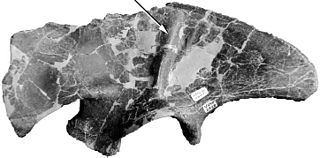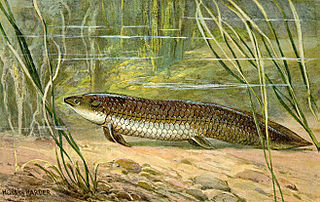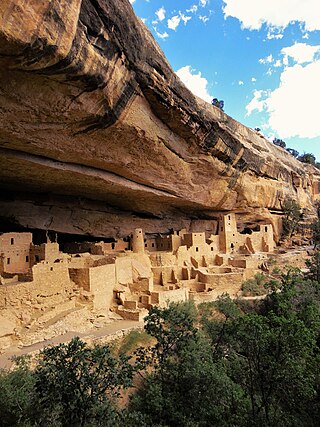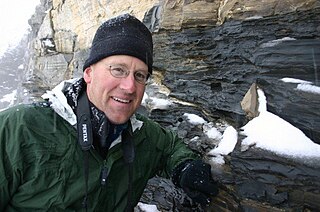Morrisonodon brentbaatar is an extinct multituberculate mammal from the Upper Jurassic Morrison Formation of North America.

The Morrison Formation is a distinctive sequence of Upper Jurassic sedimentary rock found in the western United States which has been the most fertile source of dinosaur fossils in North America. It is composed of mudstone, sandstone, siltstone, and limestone and is light gray, greenish gray, or red. Most of the fossils occur in the green siltstone beds and lower sandstones, relics of the rivers and floodplains of the Jurassic period.

Richardoestesia is a morphogenus of theropod dinosaur teeth, originally described from the Late Cretaceous of what is now Canada, the United States and Kazakhstan. It currently contains two species, R. gilmorei and R. isosceles, and a possible third, R. asiatica. It has been used as a morphotaxon to describe other theropod teeth widely displaced in time and space from the type species. If all teeth assigned to the genus are truly reflective of the animals biology and taxonomic state, it would have been one of the longest lasting dinosaur genera, perhaps also being the most widely distributed.

Camptosaurus is a genus of plant-eating, beaked ornithischian dinosaurs of the Late Jurassic period of western North America and possibly also Europe. The name means 'flexible lizard'.

Saurophaganax is a genus of large allosaurid dinosaur from the Morrison Formation of Late Jurassic Oklahoma, United States. Some paleontologists consider it to be a junior synonym and species of Allosaurus. Saurophaganax represents a very large Morrison allosaurid characterized by horizontal laminae at the bases of the dorsal neural spines above the transverse processes, and "meat-chopper" chevrons. It was the largest terrestrial carnivore of North America during the Late Jurassic, reaching 10.5 metres (34 ft) in length and 2.7–3.8 metric tons in body mass.

Stokesosaurus is a genus of small, carnivorous early tyrannosauroid theropod dinosaurs from the late Jurassic period of Utah, United States and Guimarota, Portugal.
James Ian Kirkland is an American paleontologist and geologist. He has worked with dinosaur remains from the southwest United States of America and Mexico and has been responsible for discovering new and important genera. He named Animantarx, Cedarpelta, Eohadrosaurus, Jeyawati, Gastonia, Mymoorapelta, Nedcolbertia, Utahraptor, Zuniceratops, Europelta and Diabloceratops. At the same site where he found Gastonia and Utahraptor, Kirkland has also excavated fossils of the therizinosaur Falcarius.

Ceratodus is an extinct genus of lungfish. It has been described as a "catch all", and a "form genus" used to refer to the remains of a variety of lungfish belonging to the extinct family Ceratodontidae. Fossil evidence dates back to the Early Triassic. A wide range of fossil species from different time periods have been found around the world in places such as the United States, Argentina, Greenland, England, Germany, Egypt, Madagascar, China, and Australia. Ceratodus is believed to have become extinct sometime around the beginning of the Eocene Epoch.
The Cedar Mountain Formation is the name given to a distinctive sedimentary geologic formation in eastern Utah, spanning most of the early and mid-Cretaceous. The formation was named for Cedar Mountain in northern Emery County, Utah, where William Lee Stokes first studied the exposures in 1944.
Paleontology or palaeontology is the study of prehistoric life forms on Earth through the examination of plant and animal fossils. This includes the study of body fossils, tracks (ichnites), burrows, cast-off parts, fossilised feces (coprolites), palynomorphs and chemical residues. Because humans have encountered fossils for millennia, paleontology has a long history both before and after becoming formalized as a science. This article records significant discoveries and events related to paleontology that occurred or were published in the year 1998.

Paleontology in Colorado refers to paleontological research occurring within or conducted by people from the U.S. state of Colorado. The geologic column of Colorado spans about one third of Earth's history. Fossils can be found almost everywhere in the state but are not evenly distributed among all the ages of the state's rocks. During the early Paleozoic, Colorado was covered by a warm shallow sea that would come to be home to creatures like brachiopods, conodonts, ostracoderms, sharks and trilobites. This sea withdrew from the state between the Silurian and early Devonian leaving a gap in the local rock record. It returned during the Carboniferous. Areas of the state not submerged were richly vegetated and inhabited by amphibians that left behind footprints that would later fossilize. During the Permian, the sea withdrew and alluvial fans and sand dunes spread across the state. Many trace fossils are known from these deposits.

The Cliff House Sandstone is a late Campanian stratigraphic unit comprising sandstones in the western United States.
The Colorado City Formation is a Late Triassic geologic formation in the Dockum Group of Texas, United States. It has previously been known as the Iatan Member, Colorado City Member or 'Pre-Tecovas Horizon'.
The Malone Formation is a geologic formation in Texas. It preserves fossils dating back to the Jurassic period.
The Kootenay Group, originally called the Kootenay Formation, is a geologic unit of latest Jurassic to earliest Cretaceous age in the Western Canada Sedimentary Basin that is present in the southern and central Canadian Rockies and foothills. It includes economically important deposits of high-rank bituminous and semi-anthracite coal, as well as plant fossils and dinosaur trackways.

John Russell Foster is an American paleontologist. Foster has worked with dinosaur remains from the Late Jurassic of the Colorado Plateau and Rocky Mountains, Foster is also working on Cambrian age trilobite faunas in the southwest region of the American west. He named the crocodyliform trace fossil Hatcherichnus sanjuanensis in 1997 and identified the first known occurrence of the theropod trace fossil Hispanosauropus in North America in 2015.
ReBecca Hunt-Foster is an American paleontologist. She has worked with dinosaur remains from the Late Jurassic to Late Cretaceous of the Colorado Plateau, Rocky Mountains, Southcentral, and the Southwestern United States of America. She described the dinosaur Arkansaurus fridayi and identified the first juvenile Torosaurus occurrences from Big Bend National Park in North America in 2008.

The Chama Basin is a geologic structural basin located in northern New Mexico. The basin closely corresponds to the drainage basin of the Rio Chama and is located between the eastern margin of the San Juan Basin and the western margin of the Rio Grande Rift. Exposed in the basin is a thick and nearly level section of sedimentary rock of Permian to Cretaceous age, with some younger overlying volcanic rock. The basin has an area of about 3,144 square miles (8,140 km2).










